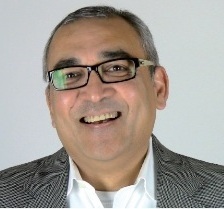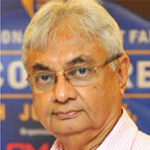My latest collection Matsutake symbolises strength, ebullience, immortality
A Humming Way (AHW) is inspired by the old-world regalia of Rajasthan state in India. The label's taste in clothing is classic, with clean and modern sensibilities in monotones, cutting across the borders and corners of the world. AHW showcased its spring/summer'20 collection Matsutake at the New York Fashion Week (NYFW). Designer and owner Sweta Agarwal was one of the six designers at the Emerging Designer Collective at NYFW. Agarwal talks about her experience at an international fashion week and the growing prominence of khadi globally.
Fibre2Fashion: Why did you decide to take part in NYFW? Is there a growing interest from US and other Western customers?
Sweta Agarwal:
The brand's collection and design aesthetics since the beginning has been that of street style, which is very much New York. This is what I call two collections going hand in hand. Going New York, going West was always something that was hovering over our mind, although we thought it was too soon for us to take the leap. Fortunately, by God's grace, they were the ones who found us and thought we should be part of their shows. That was when we thought it was time to launch ourselves there.
F2F: What excites your clientele abroad the most about your clothing?
SA:
Being very new to them, I cannot pinpoint anything specific, saying this is what happens, but what I have realised is our take on this interesting fabric khadi. They love the fabric, the feel of it and what amuses them is the versatile experiments we do with the fabric.
F2F: Tell us a bit about your latest collection.
SA:
Matsutake symbolises strength, ebullience and immortality. Woven with sheer beauty and adaptability, this mycorrhizal mushroom characterises our line with unmatched brilliance. Some species were meant to show us beauty with pure resilience, rarity with delicateness. Our collection was weaved and inspired from the priceless Asian Matsutake mushroom is a visual treat.
The aura of the Matsutake emanates an emotion that signifies a ray of hope. It breathes life even when it is in the brink of ceasing to exist. It promises to survive like a creeper in a storm. It promises to give off the exuberance of life regardless of the surrounding. Be it a junkyard or a lush forest, one crack, one groove, one crevice is all it takes for this beauty to come shining through. It pledges to teach us endurance even in a half wild, half-manufactured state.
Our garments heavily rely on Matsutake, our muse, our art, our strength. In The Mushroom at the End of the World, Anna Lowenhaupt Tsing writes: "Neither tales of progress nor of ruin tell us how to think about collaborative survival. It is time to pay attention to mushroom picking. Not that this will save us-but it might open our imaginations."
Though our regular aesthetic would be power dressing with very sharp cuts and hard cutting silhouettes, this time we tried to soften it with defined feminism. I define these sides of women that can be very powerful, sorted, sharp but at the same time, there is a soft feminism touch that comes in. That is what the garments on the runway depict, fabrics cut in manipulation, lots of craft, but soft colour, a whole amalgamation of different sides of a personality.
The highlight of the collection is that it is versatile, yet synchronised. While the colour scheme is synchronised across the collection, the silhouettes and taste of garments is versatile. The outfits were very sharp and strong, but still soft looking bubbly garments. We managed to form a connection between the two contrasts by connecting it with someone who has very powerful thoughts along with a soft mind-different sides of a personality.
F2F: How different are fashion weeks abroad from the ones in India?
SA:
I find a huge difference between the fashion shows in India and abroad. While the Indian Fashion Week is very creative and a lot of thought goes behind managing a good runway show in some of the biggest platforms in India, I found the international platform to be well organised with a keen focus on the designer's narrative and giving them opportunities to showcase to prospective buyers on a bigger scale. They knew what they were doing, with less confusion. I believe the technology used there is more advanced, which made it very easy for us to coordinate and organise the music, light, LED, the system, the styling, make-up, etc.
The make-up artists were at a different level, and the work was much better than our expectations. Similarly, the liaison teams and the organisers knew their work. For me, participation was very smooth.
In international platforms, what plays on the runway is the creativity shown in the garment. Focus on too many things and the idea of a mandatory showstopper are avoided. All these sometimes take away attention from the hard work gone in the collection by the designer and the whole team behind it.
F2F: Where do you source all the hand-woven fabrics and khadi for your collections?
SA:
I source khadi from various regions of India, mostly from a few villages near Ahmedabad. We don't merely source, we have a collaboration of sorts, where we have adopted one or two villages from where we get the khadi. We also source from some places in Jharkhand, West Bengal and are now also trying to source from South India.
F2F: Do you have your own weaving workshop or do you outsource the fabric work?
SA:
As I mentioned in the last question, there are these villages that we have adopted and have formed a collaboration. We try to create our own fabrics there by adopting a trial and error concept. We try a few of the weavings with different yarns as well. It is a collaborative concept, not in-house but not from the market as well. It is something where we are involved while weaving.
F2F: How is the market for garments made from hand-woven fabrics and handwork in India and abroad?
SA:
The fashion world has found a new perspective and openness to handwoven, sustainable, organic and earthy fabrics. So the market is definitely very huge in India as well as abroad. Like everyone else, the fashion industry too is working towards reducing carbon footprint. I cannot comment much about the overall market preference in India and abroad, but I could tell you about my garments in the two markets.
We have a very different approach to using the khadi fabric. Our garments are made for a dressy event, as occasional wear. Our concept is glamourous, red carpet silhouettes, which I believe is accepted better in the market outside India, because I think people there are more open to trying different fabrics even on the red carpet. People abroad have already accepted the outfit and I am enjoying this acceptability. It is giving me the freedom to utilise it more liberally and to do more collections out of it.
India will still take a little more time to accept that. While in India, we do wear khadi a lot, but it is more for casual events, rather than red carpet looks. Indians do not necessarily consider it a very special fabric.
But I believe the turning point has begun. It might not be established yet but yes, customers are open to it when I offer this to them. I guess they want to take a little more time to accept it completely and register. But I feel like it will happen very soon.
F2F: What do aspiring designers need to do to be able to make it this far?
SA:
I feel it is too early for me to talk about this, but I can only say that sometimes when I think what might be helping A Humming Way is that you cannot set your aims quite short. You should have a dream and need to be very clear about what you want.
This might sound philosophical, but I feel the dream needs to be there. First step is the dream, possibly a very big dream.
Personally, I don't know if it was a big dream or small, but this is what was always on my mind. And when you know this is what and where you want to go, it sets your mind and automatically nullifies the possible, seemingly big hurdles.
You eventually start ignoring and overcoming the hurdles, and manage to overcome them with time. Other than this, focus, hard work and involvement are essential.
F2F: Sustainability and circularity are the buzzwords today. How do you incorporate these in your work?
SA:
I am concerned about sustainability and circularity from the perspective of saving the environment. I try to use a few sustainable fabrics and I really want to do big in that particular line. Research on circularity is still under way. But we are working on creating a fabric made of yarns from recycled or used garments. I am already connected with a few manufacturers who treat old clothes to create fresh yarn. I will create a new fabric with that. We will then work on that fabric to create garments. It is still in the process stage.
What matters other than environment is also about co-existence with your artisans and weavers and labourers. Fair pay is important to me. We are also concerned about animal rights as we are a vegan brand. We do not promote fur, leather or silk or any material that might harm animals.
F2F: Who is your target audience?
SA:
My target audience is today's young woman, who is well-read, aware of things around her, is confident of what she wants, very sorted, does not shy away from experimenting, yet is classy and fun-loving. While it is for women of all age groups, but 20-22-year-olds will connect to my garments more because of the classic silhouettes. Women who have a personal style statement will relate more to my garments.
F2F: What is next at your company?
SA:
We plan to get into serious marketing, have a sound business plan and trying to make several changes. We have learnt a lot and we want to be at par with others. Within a month, you will see our company announcing many developments. So, please wait.
F2F: Among fellow designers, whose work do you admire? Which of them are competing with you in your genre?
SA:
I cannot comment on who is competing, I don't know much, or I cannot define where I am or where others are. But yes, I admire the work of quite a few designers. I really love Rosie Assoulin. It is very fresh, hand-woven fabric, breathable; I love what she does with it; quite inspiring. I also love Zimmer Man. She does amazing work in simple and comfy silhouettes. There are other designers whom I admire, for example Marc Jacobs. We don't need to compete with anybody; we can have our own place, identity and space in this world. (HO)



20230103183907.png)


_8.JPG)







